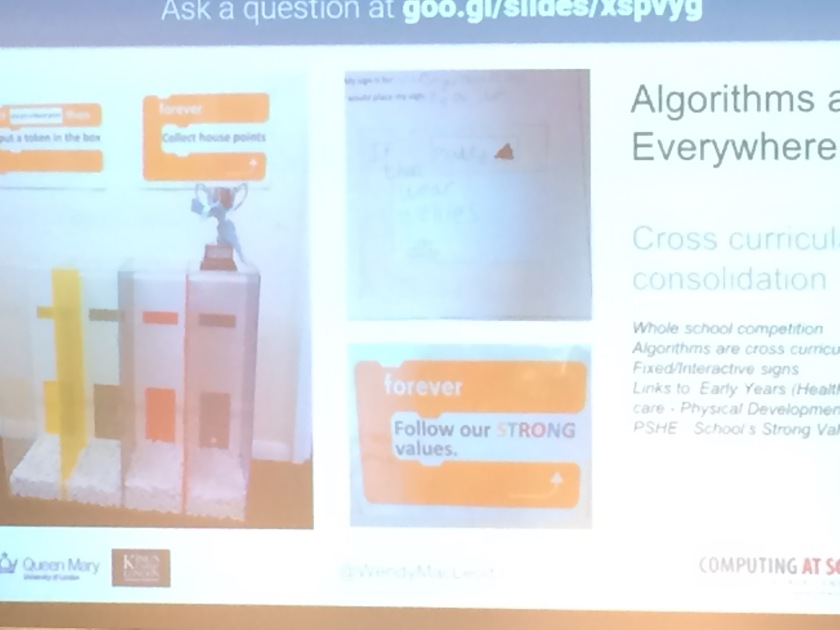As a CAS hub leader, I intended to go to the CAS annual conference last year and just didn’t make it. It’s a crazy time of year with reports, assessment deadlines and transition to think about. This year I dragged myself out of bed, feeling glum after a hard week and set off to Birmingham. However, the opening two talks set the tone for the day. So much so that I felt I could have gone home at 10.00am!
 http://twitter.com/jobadge/status/744088242853675008
http://twitter.com/jobadge/status/744088242853675008
Jane Waite, Wendy MacLeod, Paul Curzon and Nic Hughes gave a brilliant whistle stop tour of primary practise packed with fabulous practical examples, embedded in pedagogy and computational thinking.


They showed us a lovely model for using beebots by inviting children to create their own games to test their knowledge on any given subject using some simple challenge cards, a blank beebot squared grid.
A lovely idea was to use Scratch blocks to re-write signs around school. I could see how this would get children to really start thinking about how algorithms are everywhere.
Something particularly relevant to us as a Talk for Writing school is to use those principles to teach computing terminology using actions. Wendy had made a video showing her son demonstrating an action to help children remember different computing terms. I liked her suggestion that we could also think about applying the imitation, innovation and invention cycle to teaching computing.
The main keynote by Conrad Wolfram was fascinating. He very effectively raised the question of why our maths curriculum doesn’t take account of computing and computer assisted calculations. The mantra of using real life problems for children to solve has been well rehearsed. However, he put it in the context of how computing now allows us to ask questions of messy data that we never could before.
Ben Davies shared some super ideas for mini-activities, starters and plenaries in his presentation. In particular, ideas for getting children to apply what they had learned from one language to another. Could children predict what an approximation of a scratch code made from shapes in PowerPoint would do? What a lovely way to test and tease out their understanding!
Nic Hughes used his 40 minute workshop a slot wisely by challenging us to make a moving Crumble-controlled device. As a primary teacher, having some dedicated time to tinker is the best way for me to learn and gives me space to consider the pedagogy that is needed alongside the kit. His instructions were minimal which helped us think for ourselves.
Phil Bagge was awesome (as always!). He described his approach to assessing computing and made an app for assessment available. While the app looks great (utilising a matrix approach from simple/ complex to guided/independent), what grabbed me were the videos of his children talking about their computing. Phil hit the nail on the head when he said he realised that the majority of his assessment came through conversations worth his children. He took it one stage further by providing a simple way for children to reflect on their own learning using an iPad and stand to video themselves.
Crucially, he left the children to record these videos themselves (based around key questions he gave them). This enabled the children to provide their own answers without the pressure, guidance or interference of the teacher. He described how his conversations and the children’s verbalisations could be summed up as Talk for Computing. This chimed strongly with the Pie Corbett approach to teaching English that we’ve been using at school. A fascinating way to approach learning.
A session on helping primary teachers to feel confident in teaching computing had a couple of Talk for Computing gems in too. Talk to the rubber duck (link to blog by A Colley) is a great idea for children to voice their problems out loud to a rubber duck before asking the teacher. Usually verbalising their problem leads to a realisation of the solution.
The day ended with David Malan giving us a fast paced whizz through some of the early elements of CS50, an undergraduate computer science course at Harvard University. Surprisingly this contained many of the elements we teach in primary computing – search strategies and the famous Sandwich Bot which lead to the most hilarious mess of peanut butter, jam and bread courtesy of Phil Bagge’s reactions to imprecise instructions.

Finally it is worth saying that the conference was exceptionally well organised. The sessions were just the right length and there was plenty of time given over to lunch and coffee which gave space to network and drink lots of tea.
Overall I had a brilliant day, learnt loads, met some great people and felt inspired. Exactly what a conference should do! It was definitely worth getting out of bed for on a Saturday morning.



One thought on “#CASconf16 Computing At School Annual Conference”